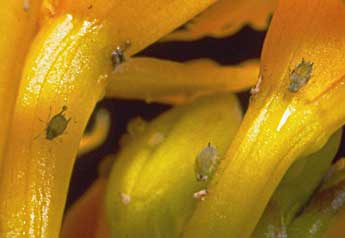Orchid Pests and Disease

If you grow an orchid for any length of time, you will finally face a care problem caused by an orchid pest or disease. Knowing how to diagnose and treat orchid ailments properly is key to becoming a good orchid grower.
Orchid Ailments
There are many kinds of orchid ailments such as Aphids, Black rot, Botrytis and so on. today we will need to look at the Aphids first.
Among the most common orchid pests, there are aphids which are slower-moving, soft-bodied insects. Normally speaking, greenish black or white, aphids have softer pear-shaped bodies, with longish legs and an antennae, which have sucking mouthparts to eat plant juices. Most of them are of the wingless type, however the winged ones seem to want to migrate within plants when a crowded colony appears.

Every day for a period of 20 to 30 days we can see that the adult female aphids gives birth to between 60 and 100 female larvas. These tiny larvas quickly begin to feed and grow, and start molting several times in order to mature to an adult female, which will be capable of reproducing within seven to ten days. within a few days thousands of aphids that will be born.
Winged forms appear, whenever colonies become overcrowded. they fly to create even newer colonies. The insects can cycle continuously under greenhouse conditions. Development rate is affected only by temperature.
In the autumn period, we have the females that start producing a few males. Those females which are born at the same time already have eggs within their bodies. The females mate with the males and then go about to lay the eggs, which provides the next season’s offsprings.
Symptoms
These insects are easy to notice. Their fast reproduction and development rapidly produces colonies, which eat the parts of the plant receiving the most nutrients. They can be found on new growth, at the base of buds, on flowers and on the undersides of leaves. Their feeding causes poor growth, stop plants from growing or curled and distorted leaves.
Developing aphids shed white skins. A large amount of them on upper leaf surfaces may be the first warnings that these causing damage insects have arrived.
Damage
The buds that are attacked will result in mold, that is if the flower tends to open at all. It will all be distorted and molted. The sap sucking may result in wilting, deformed plant growth, yellowing, and even falling off of leaves. Aphids’ salivary secretions can also be toxic to their host plant.
Aphids eat more plant fluids than they can digest, geting rid of honeydew – a sweet, syrupy material – on leaves and stems. This honeydew attracts sooty mould, a fungus that grows in honeydew, making leaves look dirty and black. Ants are very much drawn by the of the honeydew scent; they love to feed on them, and will defend it by all means. They will even keep aphids, moving them from plant to plant so that additional honeydew factories can be formed. Traveling between plants, aphids can also introduce and spread virus and disease.
Control
Prevention is better than a cure; good cultural skills and purchasing healthy plants reduce the possibility of infestation. The most common way of acquiring pests is buying an infested plant. Aphids easily colonize clean plants when they are grown close together, allowing movement from plant to plant. Winged aphids may colonize orchids that are outdoors, or indoors and in greenhouses where air currents from fans help spreading the creatures. To control the quick increase and spreads of aphids, immediately separate an infested plant from others.
Fortunately, aphids are not difficult to completely get rid of. For any curing method, repeat the procedure twice after the initial application at 7 to 10 days intervals to kill successive aphids generations. Test any curing on a small population of plants before widespread use.
To control aphids, one must also completely get rid of ants. Insecticides kill the worker ants that move and protect aphids, but the colony must be completely get rid of for total control. Sugar-based ant baits are recommended, because ants that farm aphids prefer sugar over fats.
